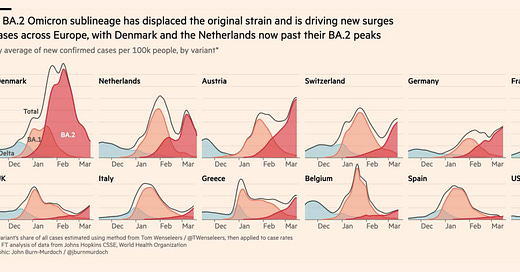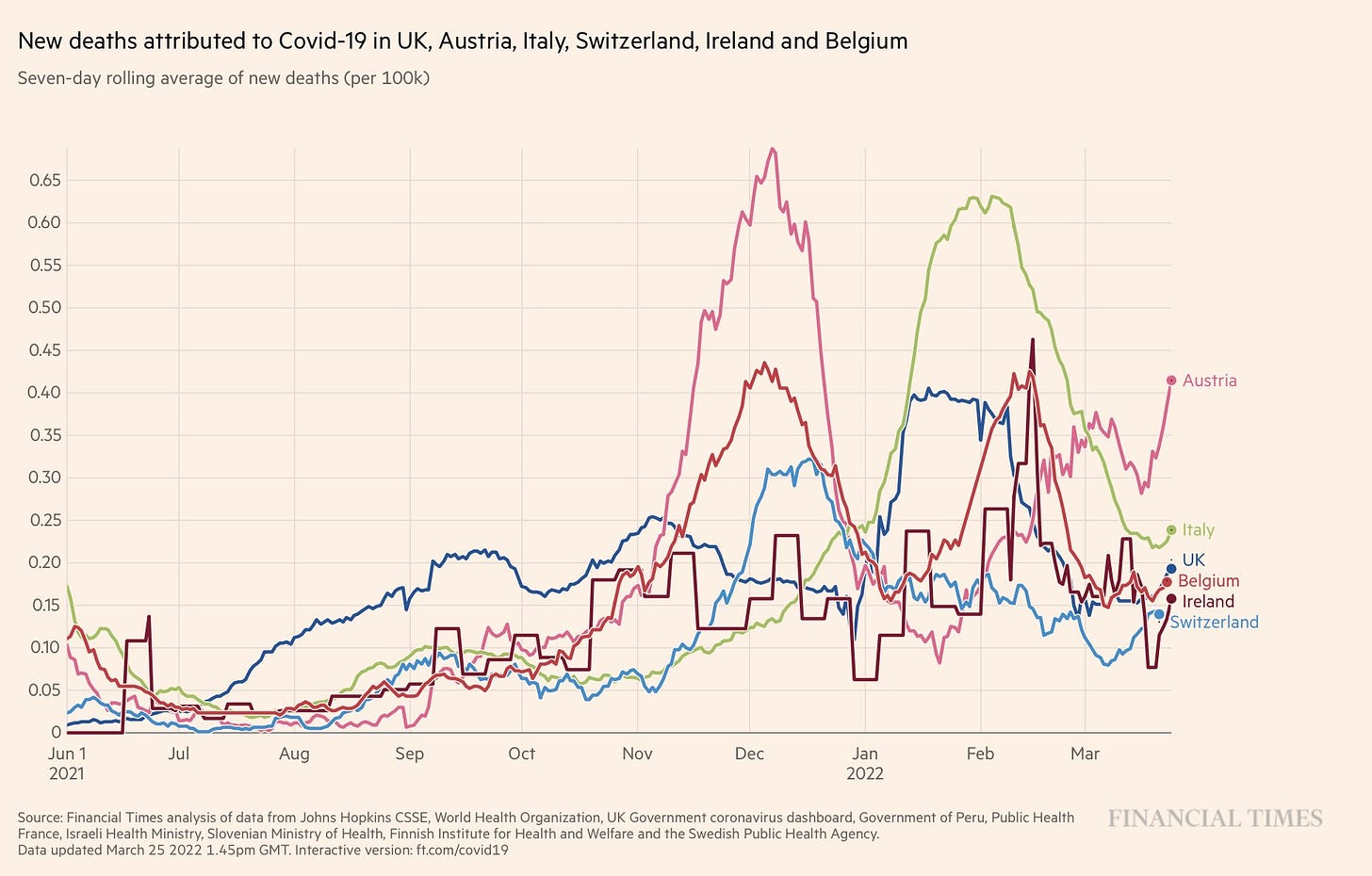The inconvenient truth is that we are going to experience a new BA.2 variant wave in the United States—the magnitude of which remains uncertain—and, this highlights the question of whether a 2nd booster (4th shot) would be useful.
In the past month, many countries in Western Europe have been going through a significant 2nd Omicron wave that is attributable to the BA.2 variant, some accompanied by a substantial rise in hospitalizations and deaths. The pattern varies by country, with some like Denmark, Netherlands and Austria having pronounced surges with BA.2 superimposed on BA.1, while others were more discrete.
Why a 2nd Omicron Wave?
Omicron is a family of variants which includes BA.1, BA 1.1, BA.2, and others. Although they share many mutations, BA.2 is quite distinct from BA.1 with 8 unique mutations. Here is the mutation map of these 2 Omicron variants. BA1.l, which was a major part of the US Omicron initial wave, and other countries, only differs from BA.1 by 1 spike mutation (R346K).
Those 8 BA.2 mutations create a substantial antigenic distance from BA.1—-how our immune system “sees” the spike protein. So there was concern that our vaccines would not be as effective against BA.2. Fortunately (yet, again, as I’ve previously written about, we’re very lucky) there is no drop-off between BA.1 and BA.2 with respect to vaccine effectiveness. For both, the protection vs infections starts out low, approximately 50%, and falls off substantially after a few months (which is why we had an enormous number of breakthrough infections in the first Omicron wave). But, importantly, the mRNA vaccines hold up well with a fresh booster against BA.1 or BA.2 vs hospitalizations and deaths. It has been estimated that about 40% of Americans were infected with the first wave of Omicron (with BA.1 or BA1.1) so there will be cross-reactive immunity/protection that should help reduce the severity of the wave, especially in people with hybrid immunity of vaccination and Omicron BA.1 infection. Here’s a summary Table of the features of the 2 main Omicron variants. Please note that the vaccine effectiveness vs hospitalization is an under-estimate from the UKHSA most recent (March 24) report. A recent study from Qatar, which also partitioned BA.1 and BA.2, showed very high (>99%) short-term 3-shot effectiveness for both Omicron variants vs hospitalizations and deaths.
The BA.2 wave is just starting in the United States
There are multiple indicators that the US wave has begun, with 8 states, Puerto Rico, and District of Columbia all with double digit increase in cases over the past 2 weeks, especially concentrated in the Northeast where genomic surveillance shows it to be the first region that has become BA.2 dominant (accounting for >50% of cases). This is confirmed with SARS-CoV-2 copies via wastewater with increases that are substantial in as many as a third of municipalities where it is monitored, even though there are only about 600 sites throughout the country. Adding to these findings, the US test positivity rate is increasing, having nearly hit 30% in the first Omicron wave and dropped to 2% by mid-March, now starting to climb at 3%. Collectively, this means we’ll have a BA.2 wave but what isn’t at all clear is whether it will be a small “bump” like our Alpha variant wave, localized mainly to Michigan and Minnesota, or substantial like some of the countries in Western Europe. That the US is at its lowest case and hospitalization burden as the BA.2 wave begins, as opposed to the start of prior waves, will help limit the impact. It is noteworthy that several countries like India, Bangladesh, and Sweden transitioned to ~100% BA.2 without experiencing a new case increase. Yes, this virus is as unpredictable as it is formidable.
What About a Second Booster?
There are only 3 studies of the 2nd booster to date, all during the Omicron wave in Israel , where these were initiated back in December 2021 for people age 60+ (previously for immunocompromised) and now are administered broadly to all adults who are past 4 months from their 3rd shot. The first study was small, looking at safety, antibody formation and vaccine effectiveness vs infections in health care workers. While the neutralizing antibody response from the 4th shot was good, the effectiveness vs symptomatic infections was quite low, only 31% for Moderna and 44% for Pfizer. The second study was in a million people age 60+ with either a 4th dose of at least 4 months out from the 3rd dose (1st booster). Follow-up was only 12+ days but a >4-fold protection against severe disease was demonstrated. The most important, 3rd study, was performed at Clalit Health, one of the 4 large healthcare organizations in Israel. It was also among people age 60+ and showed a 78% reduction of death for 4 shots vs 3 shots (post 4 or more months). This is remarkably similar to the Clalit Health report in people age 50+ with their first booster compared both only 2 shots (> 4 months out) for whom there was a 90% reduction of mortality. That study was conducted during Israel’s Delta wave. The absolute reductions in death are small in these studies (Y-axis), but the huge number of people in these age groups points to an important benefit at the population level.
This brings us to this week’s announcement by the FDA that 4th shots (Pfizer and Moderna) will be provided for people age 50+ as an option, which factors in the similarity of the data from these 2 reports. Note less divergence of the curves for Omicron in this side-by-side comparison with Delta, signifying less effect.
Should I get a 2nd booster?
The deficiency in our knowledge base is the lack of follow-up, maximal at only 40 days so far, for enhanced protection vs severe illness, hospitalization and death. Surely that’s worth something, and likely will have some durability for a few months. but It probably will have faster attrition than BA.1 protection from the Israeli data we’ve seen so far on infections. So this should be viewed as a temporizing, bridging measure.
I would recommend the 2nd booster if you are more than 4-6 months from your 3rd shot, you are age 50+, you tolerated the previous shots well, and you are concerned about the BA.2 wave where you live, or that it’s getting legs as you are trying to decide. Or if you are traveling or have plans that would put you at increased risk.
It can certainly be deferred, but the question is when is the right time, and whether an Omicron-specific vaccine will have any advantage over a 2nd booster directed at the original strain. The data from 2 animal models (macaques and mouse models) suggests there may not be advantage of the Omicron-specific vaccine but that may not correlate with its effect in people. From my discussions with FDA, it is not likely the Omicron-specific vaccine will be available before late May or June. So you can factor that uncertain added benefit and timeline into your decision.
It’s also fine to wait if there’s a low level of circulating virus where you live and work. Israel will have more follow-up data soon, and for all age groups, so in the weeks ahead we’ll know more about the magnitude, age range (such as age less than 50) and durability of the benefit.
If you had 3 shots and an Omicron breakthrough infection, there’s little need for getting a 2nd booster at this point. You’ve got some hybrid immunity and you can save an extra shot, if or when there’s ultimately supportive evidence for a later time.
If you haven’t had your 1st booster, you’re long overdue to get it. It was lifesaving vs Delta for people age 50+ and vital for maintaining high level of protection vs severe disease from the Omicron family of variants.
There’s a lot of moving parts here! As new, relevant data comes available, I’ll update this post.
You can now read Ground Truths in the new Substack app for iPhone.
With the app, you’ll have a dedicated Inbox for my Substack and any others you subscribe to. New posts will never get lost in your email filters, or stuck in spam. Longer posts will never cut-off by your email app. Comments and rich media will all work seamlessly. Overall, it’s a big upgrade to the reading experience.
The Substack app is currently available for iOS. If you don’t have an Apple device, you can join the Android waitlist here.








